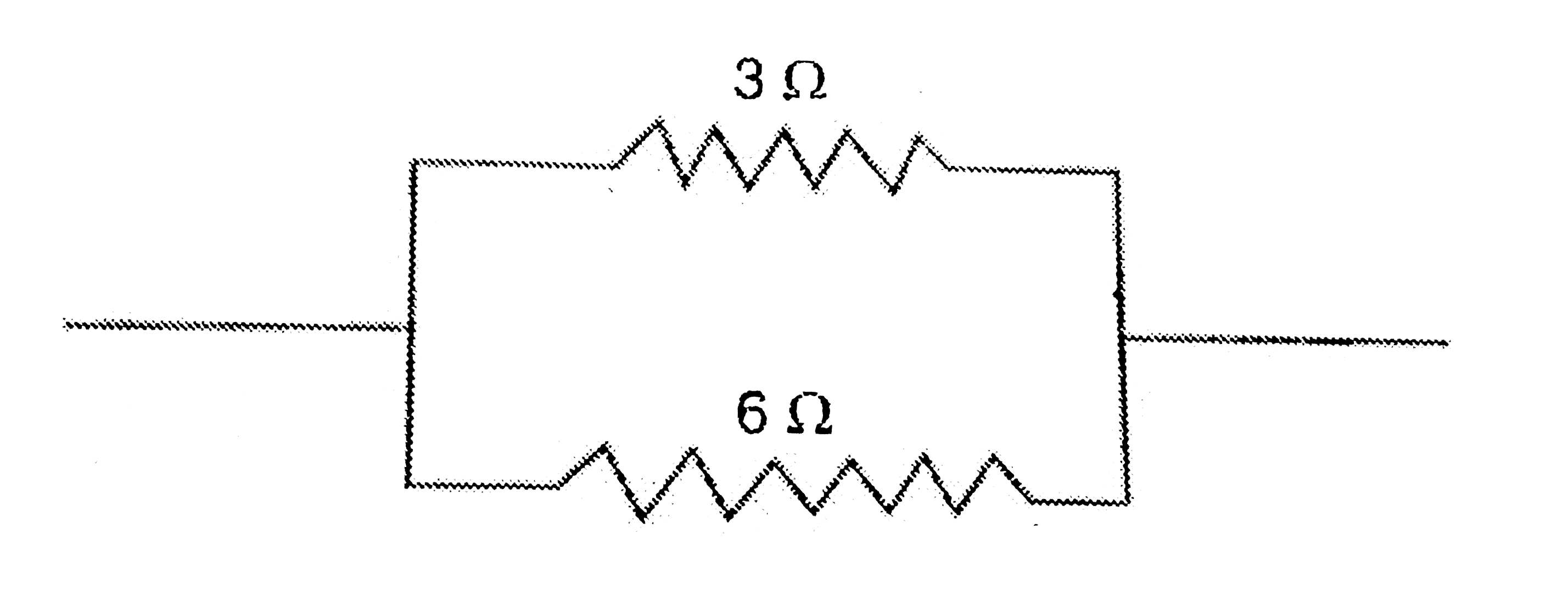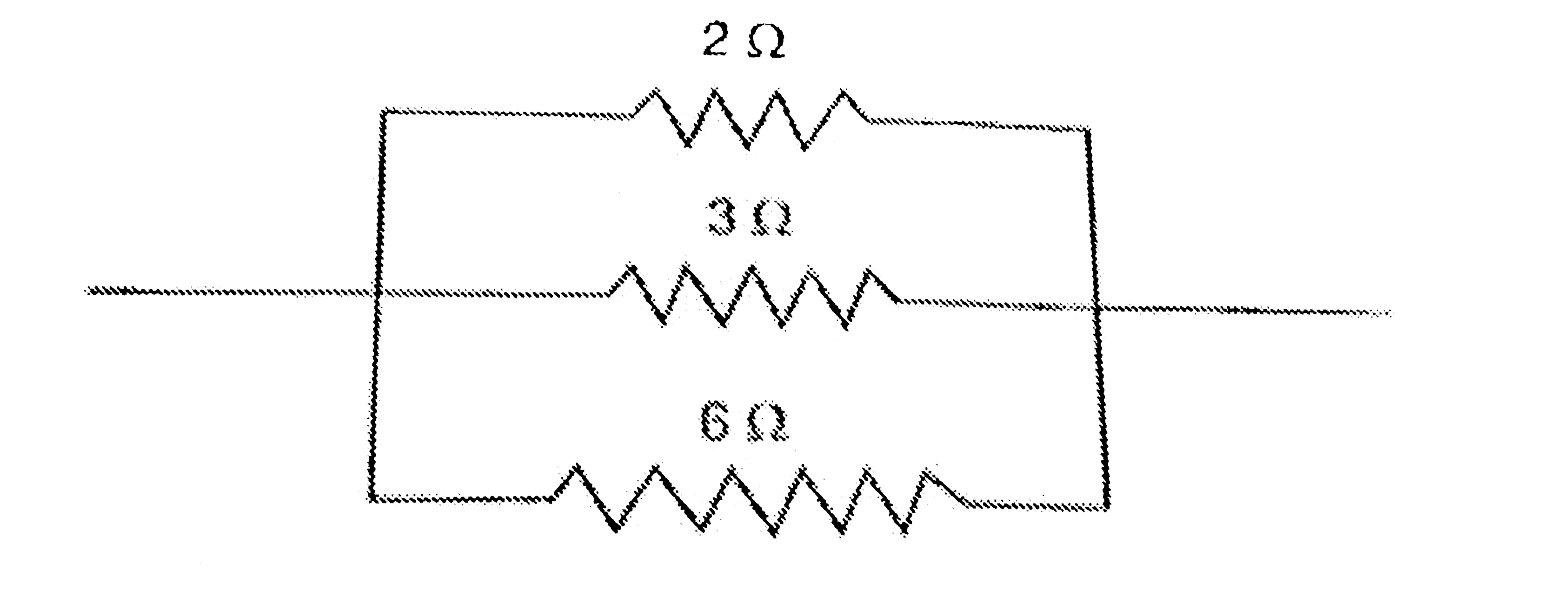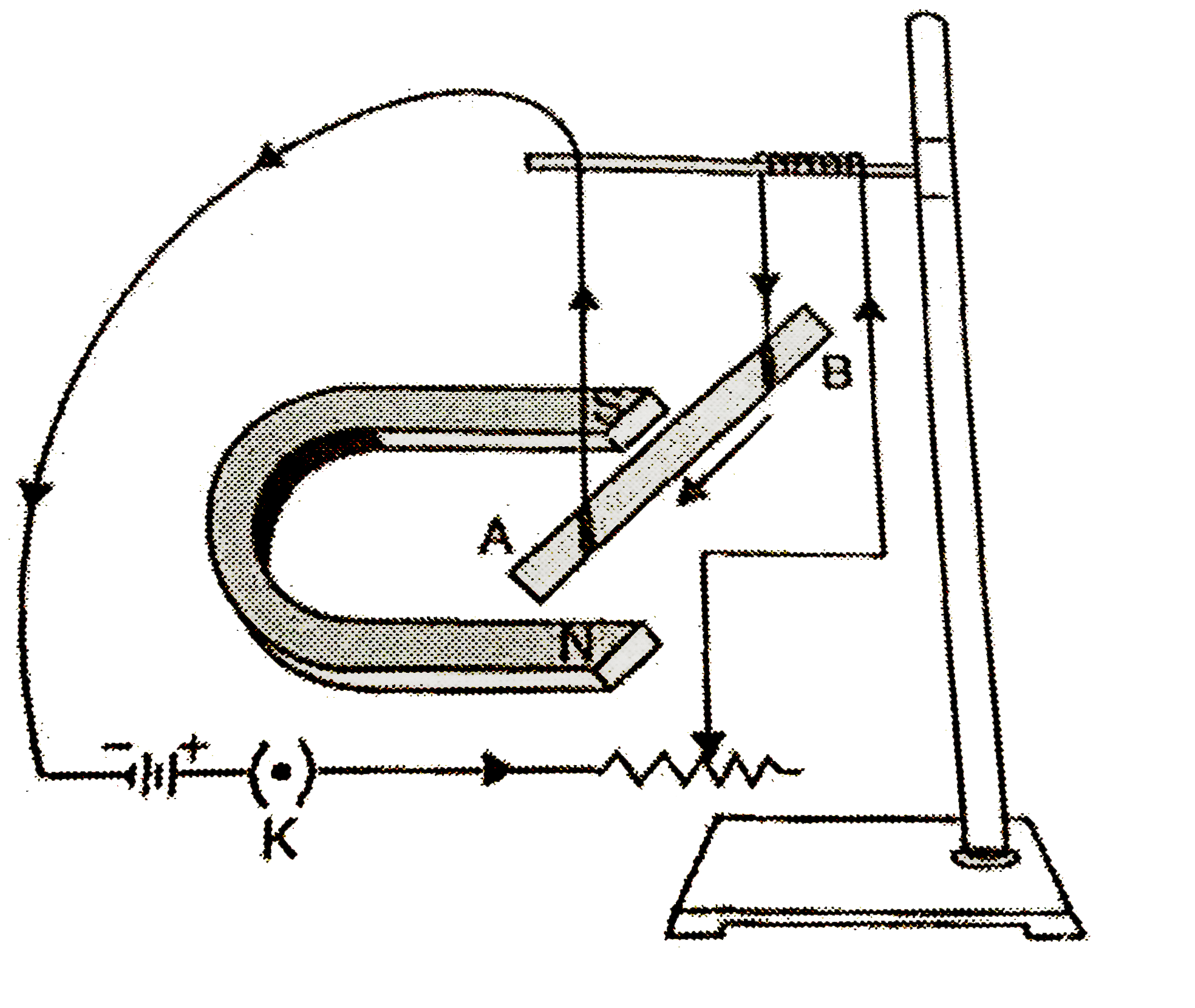How can three resistors of resistances 2Ω,3Ω, and 6Ω be connected to give a total resistance of
(a) 4Ω
(b) 1Ω ?
(a) In order to obtain a total resistance of 4Ω from three resistors of 2Ω,3Ω and 6Ω:
(i) First connect the two resistors of 3Ω and 6Ω in parallel to get a total resistance of 2Ω. This is because in parallel combination:
1R=1R1+1R2
1R=13+16
1R=2+16
1R=36
R=63
R=2Ω

(ii) Then the parallel combination of 3Ω and 6Ω resistors (which is equivalent to 2Ω resistance) is connected in series with the remaining 2Ω resistor to get a total resistance of 4Ω. This is because in series combination:
R=R1+R2
R=2+2
R=4Ω
The arrangement of three resistors of 2Ω,3Ω and 6Ω which gives a total resistance of 4Ω can now be represented as follows:

Thus, we can obtain a total resistance of 4Ω by connecting a parallel combination of 3Ω and 6Ω resistors in series with 2Ω resistor.
(b) In order to obtain a total resistance of 1Ω from three resistors of 2Ω,3Ω and 6Ω, all the three resistors should be connected in parallel. This is because in parallel combination:
1R=1R1+1R2+1R3
1R=12+13+16
1R=3+2+16
1R=66
R=66
R=1Ω

Topper's Solved these Questions
- ELECTRICITY Book:LAKHMIR SINGH & MANJIT KAURChapter:ELECTRICITY Exercise:Very Short Answer Type Questions
Explore 1 Video
- ELECTRICITY Book:LAKHMIR SINGH & MANJIT KAURChapter:ELECTRICITY Exercise:Short Answer Type Questions
Explore 2 Videos
- ELECTRICITY Book:LAKHMIR SINGH & MANJIT KAURChapter:ELECTRICITY Exercise:Sample Problem
Explore 1 Video
- MAGNETIC EFFECT OF ELECTRIC CURRENT Book:LAKHMIR SINGH & MANJIT KAURChapter:MAGNETIC EFFECT OF ELECTRIC CURRENT Exercise:NCERT BOOK
Explore 2 Videos
Similar Questions
Which of the following statements correctly defines a volt?
(a) a volt is a joule per ampere.
(b) a volt is a joule per coulomb.
View SolutionTen bulbs are connected in a series circuit to a power supply line. Ten identical bulbs are connected in a parallel circuit to an identical power supply line.
(a) Which circuit would have the highest voltage across each bulb?
(b) In which circuit would the bulbds be brighter?
(c) In which circuit. if one bulb blows out, all others will stop glowing?
(d) Which circuit would have less current in it?
View SolutionA bulb is rated at 20 V -100 W. What is its resistance? Five such bulbs burn for 4 hours. What is the electrical energy consumed? Calculate the cost if the rate is Rs 4.60 per unit.
View SolutionA small aluminium rod AB is suspended horizontally from a stand by the ends of two connecting wires as shown in the Figure given here. A horseshoe magnet is placed in such a way that north pole of the magnet is vertically below and its south pole vertically above the aluminium rod. The aluminium rod is connected in series with a battery, a key and a rheostat. How do you think the displacement of rod AB will be affected if :
(i) current in rod AB is increased ?
(ii) a stronger horseshoe magnet is used ?
(iii) length of the rod AB is increased ?

View SolutionHow can three resistors of resistances 2Ω,3Ω, and 6Ω be connected to give a total resistance of
(a) 4Ω
(b) 1Ω ?
View SolutionHow can the resistances of 2Omega, 3 Omega " and " 6 Omega be connected to give an effective resistance of 4 Omega ?
View Solution2Ω,3Ω तथा 6Ω के तीन प्रतिरोधकों को किस प्रकार सयोंजित करेंगे कि संयोजन का कुल प्रतिरोध a) 4Ω, b) 1Ω हो?
View Solution2Ω,3Ω,6Ω के तीन प्रतिरोधकों को किस प्रकार संयोजित करेंगे कि संयोजन का कुल प्रतिरोध (a)4Ω(b)1Ω हो ?
View Solution2Ω,3Ω तथा 6Ω के तीन प्रतिरोधकों को किस प्रकार संयोजित करेंगें कि संयोजन का कुल प्रतिरोध हो (a) 1Ω , (b) 4Ω ?
View SolutionHow can three resistors of resistances 2Ω,3Ω,and6Ω be connected to give a total resistance of (a)4Ω,(b)1Ω?
View Solution3Ω,6Ω तथा 9Ω प्रतिरोध के तीन प्रतिरोधकों को किस प्रकार संयोजित करेंगे, कि संयोजन का कुल प्रतिरोध
(a) 18Ω
(b) 1811Ω हो ?
View SolutionHow can three resistors of resistances 2Ω,3Ωand6Ω be connected to give a total resistance of
(a) 4Ω(b)1Ω?
View SolutionHow can three resistors of resistances 2Ω,3Ω, and 6Ω be connected to give a total resistance of
(a) 4Ω
(b) 1Ω ?
View SolutionHow can three resistors of resistances 2Ω,3Ωand6Ω be connected to give a total resistance of a] 4Ω. b] 1Ω ?
View SolutionHow can three resistor of resistances 2Ω,3Ωand6Ω be connected to give a total resistance of 4Ω
View SolutionHow can three resistor of resistances 2Ω,3Ωand6Ω be connected to give a total resistance of 1Ω ?
View Solution